|
|
Death in Venice
|
Published in Thailand Tatler Magazine - August 2005
|
Two Thai Artists Explore the Great Unknown
at the 2005 Venice Biennale
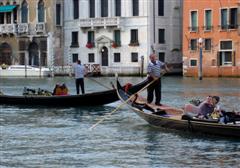 By Oliver Benjamin By Oliver Benjamin
When Marco Polo finally returned home to his native Venice after traveling for 24 years in the East, few believed the bizarre tales he told of the people who lived there: Paper money, rocks that burned, enormous sheep and staggering wealth. It was too strange to accept and virtually no one did. On his death bed he refused to recant his tales. “I have not told half of what I saw,” he insisted, and history has exonerated him.
The world is much smaller now, of course, and there are few uncharted areas to explore. Still, there is a state that many have wondered about, speculated upon and heard rumors of, though few have ever visited it. That is: the state of death.
Death is still the greatest question mark, the “final frontier,” and one that few dare to cross. Though a few guidebooks have been written, reports of the trickle who have gone and come back differ considerably.
This year, however, the works of two Thai artists have brought to Venice a fresh investigation on this oldest of unknowns. Their joint exhibit at the 2005 Venice Biennale has forced the normally death-shy occident to examine morbidity with Asian eyes.
The exhibit, entitled “Those dying wishing to stay, those living preparing to leave” not only presents death to the West from an Eastern angle, but it bisects that angle once more. The subject is approached from two different points of view, each stemming from the contrasting life-experiences of the artists themselves.
Those dying wishing to stay
Montien Boonma’s works were inspired both by the shattering loss of his wife to breast cancer in 1995 and ultimately his own struggle with lung cancer and a brain tumor, which ended fatally in the year 2000.
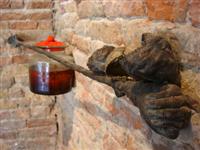 Boonma’s work was distinguished by his use of traditional Thai artifacts, though he liked to employ them in utterly novel ways: A “House of Hope” is constructed from hundreds of hanging Buddhist prayer beads, a jar of medicinal Thai whisky hangs precariously on a human arm bone and jaw, and a collection of giant rice bowls is completely lined inside with concentric rings of teeth. Through all of these works Boonma wished to draw attention to the impermanence in our lives and the world around us. The “house” looks solid from a distance but at close view is diaphanous – you can walk straight through it. The whisky jar is close to falling, indicating the instability of medicinal cures. Finally, the bowls lined with teeth allude strikingly to the dictum that the consumer must ultimately become the one consumed. Boonma’s work was distinguished by his use of traditional Thai artifacts, though he liked to employ them in utterly novel ways: A “House of Hope” is constructed from hundreds of hanging Buddhist prayer beads, a jar of medicinal Thai whisky hangs precariously on a human arm bone and jaw, and a collection of giant rice bowls is completely lined inside with concentric rings of teeth. Through all of these works Boonma wished to draw attention to the impermanence in our lives and the world around us. The “house” looks solid from a distance but at close view is diaphanous – you can walk straight through it. The whisky jar is close to falling, indicating the instability of medicinal cures. Finally, the bowls lined with teeth allude strikingly to the dictum that the consumer must ultimately become the one consumed.
Other works of his on display include his “Sala of Mind” and “Melting Void: Molds for the Mind.” These are giant suspended “hats” in which the visitor must place his or her head and contemplate their own thoughts and beliefs. The former features steel rings perforated by question marks and the latter is made from an actual mold used to fashion giant Buddha images. Both are dark spaces penetrated with bits of light and sound, helmets of refuge where Boonma wanted to offer visitors a chance to feel calm and content, semi-detached from the living world of the senses.
In playing with our presumed hopes and conceptions, as well as offering places to contemplate emptiness, Boonma tried to help us accept en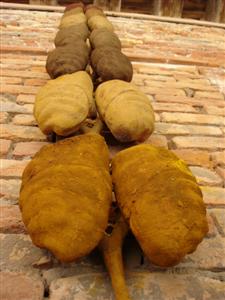 tropy: Things inevitably fall apart. By accepting this and striving to achieve a still state – what he called “death before dying,” he hoped to ease his own difficult transition into Buddhist non-being. tropy: Things inevitably fall apart. By accepting this and striving to achieve a still state – what he called “death before dying,” he hoped to ease his own difficult transition into Buddhist non-being.
Ironically, Boonma’s investigations into his own impending death provided him international renown, allowing him to transcend the very mortality that inspired him. Furthermore, as this series helped put Thailand on the map of international contemporary art, it has blazed a trail for other artists in this overlooked part of the world. From Boonma’s death, one can say, a riot of new life has sprung.
Those living preparing to leave
Araya Rasdjarmrearnsook, on the other hand, is still very much alive. This cheerful 47-year old teacher at Chiang Mai university has the bright eyes and infectious laugh of someone half her age. And yet her early years were marked by a seemingly 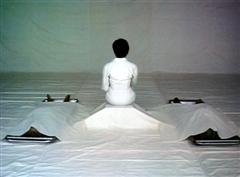 endless succession of loss: Between the years of 3 and 6, she attended the funerals of her great-grandmother, grandmother, mother and baby sister. Perhaps as a result of this, she became attracted to the ceremony, beauty and pathos of funeral rituals, and later in life made a point to attend as many as possible. Consequently, she approaches death with great compassion, trying to show that death need not be negative, indeed that it can even have, in her words, a type of “charm.” endless succession of loss: Between the years of 3 and 6, she attended the funerals of her great-grandmother, grandmother, mother and baby sister. Perhaps as a result of this, she became attracted to the ceremony, beauty and pathos of funeral rituals, and later in life made a point to attend as many as possible. Consequently, she approaches death with great compassion, trying to show that death need not be negative, indeed that it can even have, in her words, a type of “charm.”
Rasdjarmrearnsook’s selected works at the festival elicit a wide range of responses and emotions from visitors. This is not surprising: They are all video installations in which she interacts with a room full of actual human corpses. Her intentions, however, are not to disturb the viewer. Rather, the screens are meant to be reflections of whatever we ourselves already feel about death. Employing prose borrowed from Buddhism she says: “It can be positive if one loves and appreciates one’s life, it can be negative if you are a mundane container among non-containable containers.”
“Conversation I-III” features the artist among an array of corpses covered with sheets, only their feet and the tops of their heads exposed. Various screens show her walking in and out of the frame, or sitting upright between them. Only an ominous hum is audible in the semi-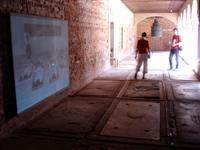 darkness. It is impossible not to think of the horror movie The Ring, perhaps the most famous marriage of video and death to date. The effect is both peaceful and unsettling, evoking the liminal space between sleeping and waking. Or, perhaps, between life and death. darkness. It is impossible not to think of the horror movie The Ring, perhaps the most famous marriage of video and death to date. The effect is both peaceful and unsettling, evoking the liminal space between sleeping and waking. Or, perhaps, between life and death.
More pleasant and engaging is “The Class,” an extraordinary juxtaposition of death and satire. In it, Rasdjarmrearnsook gives a lesson on death to a classroom of six prostrate corpses, advising them on aspects of death and asking them questions even though she hilariously admits, “I am willing to accept the fact that this talk might be without any form of discussion.” The piece is meant to parody academic professors (and possibly art critics) who claim to profess knowledge on subjects about which they could not possibly understand. As a teacher herself, Rasdjarmrearnsook readily admits that she is teasing herself here to some degree as well. As in the other pieces, the compassion she feels for the dead is obvious. In parodying the attitudes of the living she makes it clear that we are not “above” the dead, and that in some arcane sense we may have a lot to learn from their condition.
Finally, in the most empathetic of her pieces, “This is Our Creations,” the artist lies down with the dead in an attempt to commune with them and know their state, if but for a moment. She intones: “I came here to know you, lying here motionless. Once my father sent me a postcard from very far away. Its sentence: only a still pond can reflect the stars.” And we, standing there silent and still, have no choice but to join her in that reflection.
Venice: City of the Dead
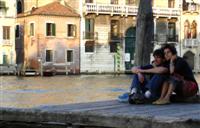
For an investigation of death, the location chosen to present this exhibit is uncannily appropriate. It is housed in the monastery of San Francesco Della Vigna, just across the water from one of the most extraordinary cemeteries in Europe: San Michele, an island of the dead. The cemetery covers its entire area, and features the remains of Igor Stravinsky, Ezra Pound and other celebrated artists. Incorruptible plastic flowers decorate the graves, giving the whole island an air of a people resolutely determined to deny death its power over them.
The monastery itself is even more striking: look down and you’ll notice that the walkways around its central garden are made up of ancient tombs of former monks. It is in these very walkways – literally on top of the Franciscan tombs – that the Thai artists’ works are displayed. The stark contrast between oriental and occidental approaches to death could not be more palpable here: Enduring stone tombs and isolated island cemeteries on the one hand, ashes, incorporeality and impermanence on the other.
Moreover, the city of Venice presents itself as a perfect location for an investigation of death through art. Thomas Mann did just that almost 100 years prior in his famous novel, “Death in Venice.” In it, one man’s obsession with the aesthetic ideal grows so great that, like a moth to a candle, it leads him inexorably to his own demise. The setting was a conscious choice for Mann: a city without soil and virtually no vegetation, a city that has lost all of its former mercantile glory and been reinvented as a tourist mausoleum to its own grand past. A city, in short, of death. But also, like the obsession of Mann’s protagonist’s desire, a city of inexhaustible and immortal beauty.
Light in the Shadows
One of the central themes of Mann’s book is the danger of psychological repression. Mann penned his book in 1912, exactly at the time when Freud’s theories 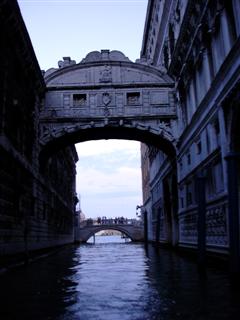 of the subconscious were becoming accepted and many in Europe had begun to rebel against the conformist pressure instilled during the Victorian era. Mann himself was struggling with his own repressed homosexuality and no doubt found that he could explore these feelings more freely in his literature than in his life. of the subconscious were becoming accepted and many in Europe had begun to rebel against the conformist pressure instilled during the Victorian era. Mann himself was struggling with his own repressed homosexuality and no doubt found that he could explore these feelings more freely in his literature than in his life.
And though, now, almost a century later many of us are so much freer to openly explore our deepest desires, death is still something few feel comfortable discussing in polite company. Yet throughout history art has always been the greatest channel for catharsis. As Rasdjarmrearnsook notes, “Because desperate longing cannot find solution in other forms, art is the only way out to it.” In “The Class,” she instructs the dead pupils, “I would like to suggest that maybe there is more freedom in dealing with death in art and literature [than in daily life]. In my opinion art can play with the meaning of death. Art can approach it from different angles. Death becomes a feather in the wind.”
Her series of revealing white video screens in the shadows of the monastery’s stone halls are like windows through which we can examine that feather, views out onto a world we must all someday visit. “Did you experience a charming death?” she asks the group of “mundane containers” lain out before her. It is clear that she is not directing the question to them, she is asking it to herself, and to us.
Only a few months before this exhibit opened, over 200,000 people lost their lives in the wake of the great Tsunami that washed over Southeast Asia. Some 8,000 of these perished in Thailand, though many were tourists from all over the globe. The international outpouring of grief over the senselessness of the massive death brought an increasingly fragmented world closer together. But Rasdjarmrearnsook contends that the horror of so many people dying at once, relayed through naked images all over the world, robbed death of its tenderness and individual dignity.
By suffusing death with compassion and beauty, both of these courageous Thai artists have helped to bring some much-needed dignity to death by casting light upon the shadows of our fear. Like metaphysical Marco Polos, they have traveled to places few dared go and brought back rare treasures we can all stare at with wonder and awe. Boonma is now forever in that far Asia, but we can surely expect more revelations from Rasdjarmrearnsook, who as the foremost female artist in Thailand still has much traveling to do.
The exhibit will continue through November 6, 2005.
Information:
Those dying wishing to stay, those living preparing to leave
51st International Art Exhibition, La Biennale Di Venezia, 2005
Thai Pavillion at the Convento San Francesco della Vigna, Venice Italy
June 12 to November 6, 2005
10 a.m. – 2 p.m. and 4 p.m. – 6 p.m. (June 12 – September 20)
10 a.m. – 2 p.m. (September 21 – November 6)
|
|
|
All text and images © copyright Oliver Benjamin |
|
|
|
|

